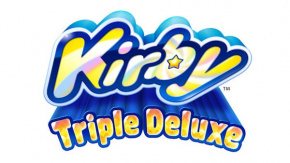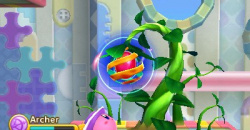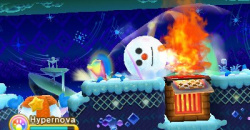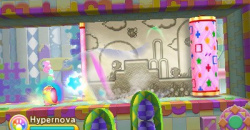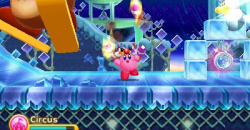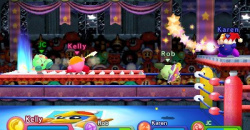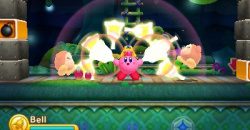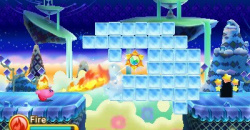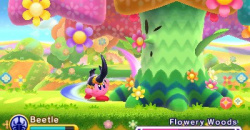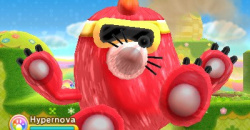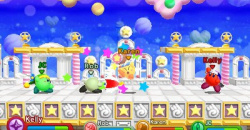After nineteen titles to his name and tons of guest appearances in different genres, Kirby’s back. This May, fans in both North America and Europe can get their hands on the latest adventure featuring everyone’s favorite jolly little pink blob. Have Nintendo and developers HAL Laboratory given us another hit? Read the test review to find out.
Storyline
Everyone deserves a break every now and then, and video game heroes are no exception. Rescuing princesses, thwarting villains, and saving kingdoms – it’s a tough job. After a hard day’s work, Kirby’s just gotten cozy in his bed and dozed off, with no idea of the adventure that awaits him. While he’s sleeping, a magic beanstalk (called the Dreamstalk) grows beneath Dream Land, taking Kirby, his house, and much of Dream Land high into the sky. The next morning he finds himself in a strange new land, and he sets off for King Dedede’s castle, arriving just in time to witness the self-proclaimed king of Dream Land being abducted by an unknown, six-armed creature. Why King Dedede has been captured, and where this creature is taking him, no one knows. But there’s no need to even ask who’s going to rush to the aid of his erstwhile nemesis. Thus begins Kirby’s latest adventure, as he sets off in pursuit of this strange new foe.
Gameplay
Tarzana, the king’s kidnapper, doesn’t make it easy for Kirby. He follows the villain through various themed worlds – jungle, desert, frozen wasteland, etc. The different levels don’t just look different, but each involves differences in gameplay, providing a good deal of variety. For example, in ghost stages, the enemies are only visible in mirrors, and in water levels Kirby will have to swim to get around. The developers show tremendous amount of creativity here, and never seem to run out of ideas. Each new level raises expectations for the next one.
One thing all the worlds have in common, however, is that they are each divided into five stages. You finish them one after another as you look for Sun Stones, which you need in order to unlock the boss stage at the end of each world. Only when you’ve collected enough of these stones can you confront the world’s boss and move on to the next one. Then it starts all over again. It’s not necessary to collect each and every one of the Sun Stones, but if you reach the end without having found enough of them, you’ll have to replay the stages you’ve already completed in order to find them.
In classic platformer fashion, you jump, run, fly, or swim from left to right through a 2D, or rather “2.5D” environment, always on the lookout for a secret passage or for the next puzzle to solve. A pleasant excursion for Kirby, perhaps, if each world wasn’t full of henchmen standing in his way with a variety of attacks and attempting to stop him from getting any further. As we all know, Kirby’s not much of a shooter or a brawler, but prefers to inhale all the enemies in his path and spit them back out – at least those close enough for Kirby to suck them in.
The development team has done a very good job of ensuring that although the game is 2D, it’s not limited to one plane of action in the same way most traditional platformers are. Basically, everything you see on the screen, including the foreground and background, is a part of the level’s field of play. You can use “3D Warpstars” to change the plane of action at certain spots in the level, so be sure to always keep an eye out for enemies and other hazards. This feature really makes you want to explore each stage, and it often plays a role in the various puzzles found throughout each world. It’s also a good way to find Sun Stones and other items, as well as various “keychains” found hidden in every stage. Though they have no direct impact on the game, these keychains are a lot of fun to collect. They depict various characters from past Kirby games modeled as 2D sprites.
You’re going to find yourself having to move into the foreground or the background in order to activate switches or to find keys to doors you’ll need to open in order to continue on. Little brain teasers taking advantage of the Nintendo 3DS’s hardware capabilities are also well-integrated into the game. For example, the device’s motion sensor is used to set pendulums in motion or empty water barrels to put out fires so Kirby can get through. Kirby’s Copy Abilities are also back in this game, and five new ones have been added. Copy Abilities (and the distinctive costumes that go with them) don’t just give our little hero a range of new attacks and powers, but are sometimes even necessary to get past certain sections in the game. For example, only Fire Kirby can light fuses, and certain remote targets can only be reached by Archer Kirby. When an enemy with certain abilities crosses your path, you can suck him in to steal his powers, hence “Copy” Abilities. Use Spear to become a mighty warrior, Archer to shoot arrows across the screen, or Wheel to dash through levels like Sonic the Hedgehog. In certain places you can find pieces of the Dreamstalk, called Miracle Fruit. Inhaling these will give Kirby the “Hypernova” Copy Ability, which increases his sucking power tremendously, giving him the ability to swallow large objects that are usually immovable, like buildings and even whole trains.
Kirby’s Copy Abilities are limited only by his own life bar, or by enemies who can rob his powers. Or he can also drop an ability to take on a better one. When Kirby loses or drops a Copy Ability, it will bounce away as an Ability Star, which he can suck back in at any time. Each Copy Ability has its advantages and disadvantages, and the sheer variety of them opens up a lot of possibilities for experimentation. So in the first half of the game, we’re bombarded with tons of variety and clever and well-thought out puzzles. However, it’s not really possible to keep things at this level for too long, and soon we know what to do, and things seem a lot less challenging, as the game’s difficulty doesn’t really increase. The same goes for the minibosses you have to defeat in every other stage. Most of the time they’re pretty easy to figure out after a few attacks, and are quickly defeated without a whole lot of effort.
The boss battles at the end of each world are a different story. In these encounters, your opponents’ behavior differs with each new offensive, and it takes a good deal of skill to avoid their attacks and then find their weak spots so you can get your own attacks in. Each battle lasts several minutes, and you have to be sure you’ve mastered the game’s controls and know how to make the best use of the Copy Ability you’re using. While the game is still fair during these engagements, don’t expect it to let you off easy either. When and if you win, be happy with it, because you’ll have earned it.
If you’re looking for something different after a few hours of gameplay, there’s no need to put the game down. Kirby: Triple Deluxe also includes two sub-games – Kirby Fighters lets Kirby choose a Copy Ability to battle other Kirbys in various arenas, with a multiplayer option, of course. Dedede’s Drum Dash is a rhythm game that has King Dedede bouncing along a series of drums and clapping to the beat of various classic Kirby songs. This game mode only has three levels, but that’s no big deal, as it’s not really anything to write home about.
Graphics and sound
I wasn’t exactly blown away by the graphics in Kirby: Triple Deluxe, but they still look great, even compared to other games from Nintendo. Landscapes are beautifully portrayed and really well designed, and the animations are great, too. They did an especially good job animating Kirby himself, and players will soon grow fond of the little vacuum cleaner. You can really see here how much attention the designers paid to detail, and sooner or later you’ll find yourself smiling as the little hero does his victory dance after completing a level. The storyline pretty much tells itself, making voice acting and even captions unnecessary. Minibosses and bosses live up to their name, and the way they’re integrated into the levels, as well as the shower of effects accompanying them, ensure that they’ll remain an unforgettable part of the game. But the game’s true graphics quality can really be seen in the 3D effect that makes everything in the game look almost like it’s made of plastic – and fortunately at no cost to frame rate. The soundtrack provides a good backdrop to the action on screen, and always fits the individually themed worlds.
Multiplayer
Kirby: Triple Deluxe takes advantage of the 3DS’s StreetPass functionality, rewarding you with items and power-ups whenever you “meet” other 3DS owners. You’ll receive these items from a creature in-game, and some of them can even be stored up and used whenever you need them.
In addition to this, the Kirby Fighters sub-game features a multiplayer function. Kirby Fighters looks like something Kirby took back home with him from his appearances in the Super Smash Brothers series – up to four opponents can duke it out in an arena, where they can choose from any of the Copy Abilities already found in the single player game. A nice little pastime designed for those occasions when four friends who own a Nintendo 3DS get together, as unfortunately there’s no online mode here. You can also play Kirby Fighters in single-player mode, but fighting against the computer isn’t really all that much fun.
Official Trailer





